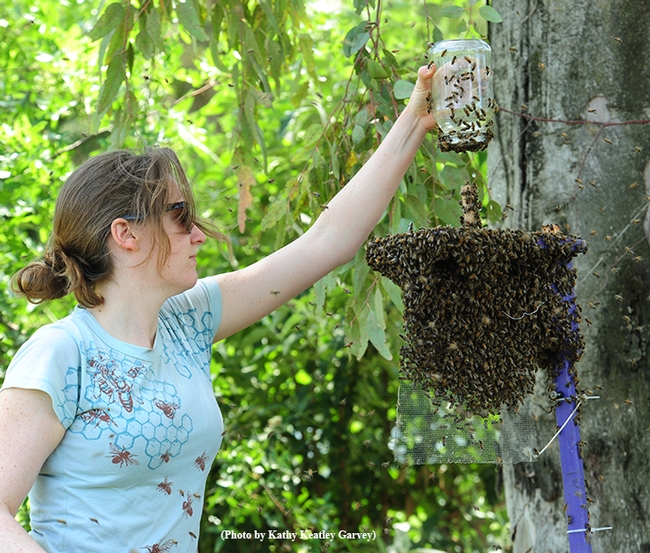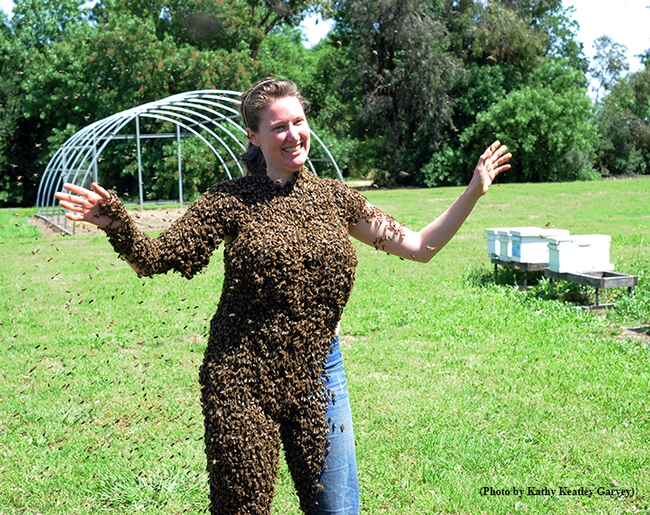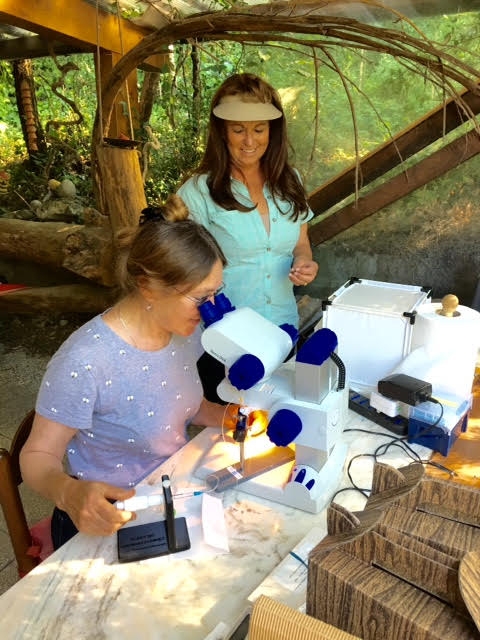- Author: Kathy Keatley Garvey
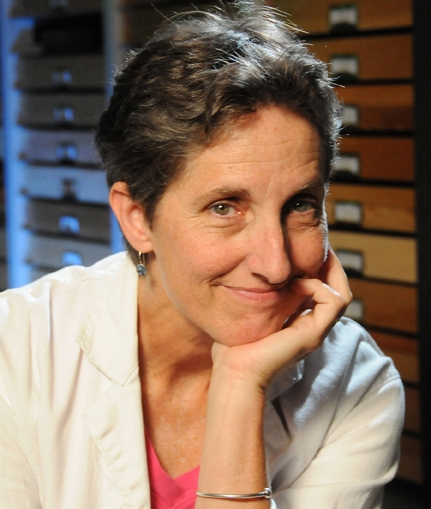
First there were the Africanized honey bees, which sensationalists called "the killer bees."
Don't even mention "assassin flies" or "bullet ants" or "deathwatch beetles."
Now there are the Asian giant hornets (AGH), Vespa mandarinia, which sensationalists have dubbed "murder hornets."
"It's ridiculous to call them murder hornets,” says noted UC Davis wasp expert and researcher Lynn Kimsey, director of the Bohart Museum of Entomology and professor of entomology, UC Davis Department of Entomology and Nematology.
“It's no more likely to sting and kill a human than a honey bee,” said Kimsey, a two-term past president of the International Society of Hymenopterists, an organization that studies bees, wasps, ants, and sawflies.
“Actually it's less likely, as honey bee venom packs quite a punch and it is exclusively designed to defend against vertebrates,” she said.
“The colony everyone is hyperventilating over was actually found on Vancouver Island, British Columbia, last September when it was destroyed and then a single, dead hornet was found in December in Blaine, Wash.,” Kimsey said. “There is no evidence that there are any more hornets in the vicinity of Vancouver or anywhere else on the West Coast.”
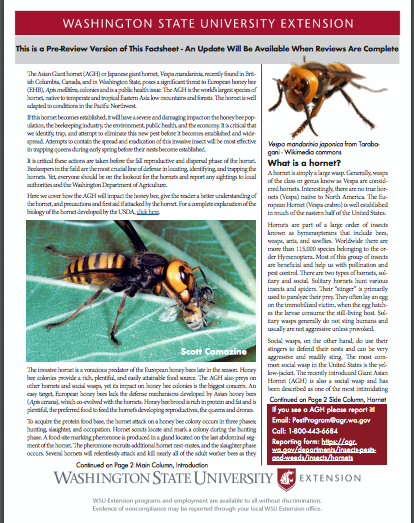
These were the first detections of this species in North America, but there may be more, according to the Washington State Department of Agriculture (WSDA). Beekeepers have reported “observations” (which may or may not be the same species) dating back to October 2019, according to officials in Washington State University's Department of Entomology and Cooperative Extension. They and the beekeeping organizations want to know what's out there and they want folks to keep a lookout for them.
Said Kimsey: “A decade or more ago there was a colony of another species, Vespa asiatica, reported near the Port of Long Beach but nothing ever came of that either. A European species, Vespa crabro, was introduced into the East Coast perhaps a century ago and it is now fully established in the southeastern U.S.”
Kimsey points out that insects often come in cargo boxes from Asia to U.S. ports, establish colonies, and expand their range.
A soon-to-be-published article in the Entomological Society of America's journal, Insect Systematics and Diversity, promises to shed more light on the genus and the history of introductions in the United States.Kimsey and colleagues Allanmith-Pardo of the USDA and James Carpenter of the America Museum of History, New York, co-authored the review article.
In the abstract, the authors define Vespa as social wasps that are “primarily predators of other insects, and some species are know to attack and feed on honey bees, Apis mellifera, which makes them a serious threat to apiculture.”
“Vespa nests can be physically large, with over 1,000 workers, but usually with hundreds of workers,” they wrote. “Nests can be aerial, attached to tree branches or in shrubs, in crevices, under eaves or underground depending on the species. Depending on the latitude, nests can be either annual, started by a new queen every spring, or perennial, where young queens take over from old ones. Colonies in warm tropical climates tend to be perennial.”
Washington State University (WSU) Extension recently published an AGH fact sheet, the work of three scientists: Susan Cobey, bee breeder-geneticist and husband Timothy Lawrence, county director of Island County Extension (both formerly of UC Davis), and Mike Jensen, county director of Pend Oreille. (See https://bit.ly/2SA3TxS)
Yes, hornets are huge. They measure about two inches long, and the queens can fly up to 20 miles per day, said Cobey, who examined specimens in Japan last December and shipped some of them to WSU.
The WSU scientists wrote that AGH “is the world's largest species of hornet, native to temperate and tropical Eastern Asia low mountains and forests. The hornet is well adapted to conditions in the Pacific Northwest.”
“The primary purpose of venom is defense against predators by inflicting pain and damage,” they wrote. ”Vespa mandarinia is one of the two most venomous known insects in the world.. The amount of venom each wasp delivers (4.1 μl/ wasp) has designated V. mandarinia as the most venomous insect. In comparison, the honey bee has about 0.6μl/bee. When foraging for food in spring, the AGH is not highly defensive – unless its nest is disturbed. Late summer and fall, with the high demand for protein, they become very aggressive when attacking or occupying a honey bee colony.”
“It is critical that we identify, trap, and attempt to eliminate this new pest before it becomes established and widespread,” they wrote. “Attempts to contain the spread and eradication of this invasive insect will be most effective in trapping queens during early spring before their nests become established. Finding the nests can be a bit of a challenge. Their nests are typically in the ground though they can also be found under overhangs and within wall voids. The AGH is a strong flier and often will fly up and away and have an extensive flight range. Thus tracking can be difficult.”
They advise residents to “proceed with extreme caution and contact WSDA immediately. Do not try to exterminate the nest yourself.”
Entomologists call them Asian giant hornets or Vespa mandarinia.
Social media?
Murder hornets.
Could we just go back to calling them Asian giant hornets or AGH or Vespa mandarina?
Please?
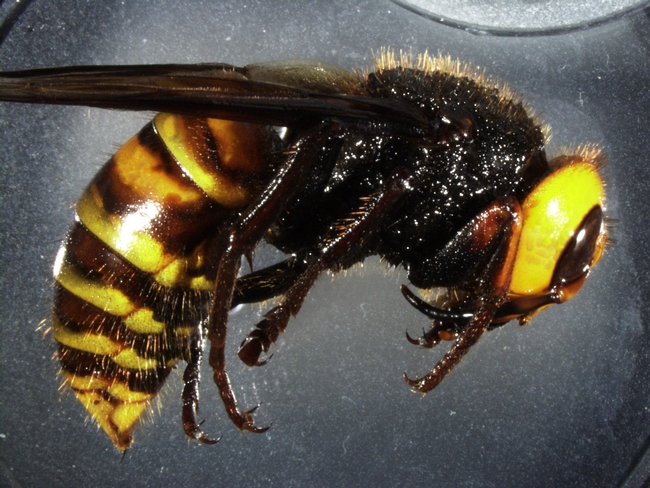
- Author: Kathy Keatley Garvey
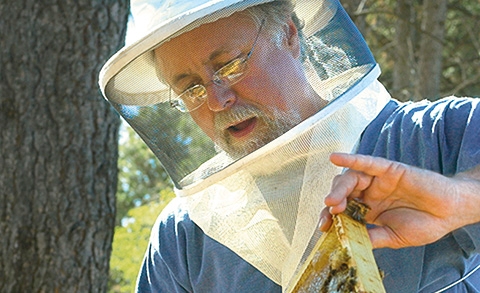
It's the work of Washington State University's Honey Bee Research Program, College of Agricultural, Human and Natural Resource Sciences (WSU CAHNRS), and accessible free online on Vimeo at https://vimeo.com/380776410.
The 28-minute video, two years in the making, is aimed at helping beekeepers improve their stock and overcome some of the obstacles they may face in their breeding efforts.
The UC Davis connection is strong. The video chronicles the work of "the father of honey bee genetics," Harry H. Laidlaw Jr., of the University of California, Davis, for whom the Harry H. Laidlaw Jr. Honey Bee Research Facility on Bee Biology Road, UC Davis, is named. The husband-wife scientific team, Susan Cobey and Timothy Lawrence, both formerly of UC Davis and now of WSU, are executive producers and are featured in the video, as is noted bee scientist Steve Sheppard, director of the WSU Center for Reproductive Biology and former chair of the WSU Department of Entomology. The trio, also the authors, describe the Page-Laidlaw Population Breeding Program, one of the most successful bee breeding program and named for Laidlaw and Robert E. Page Jr., now a distinguished emeritus professor at UC Davis and emeritus provost, Arizona State University.
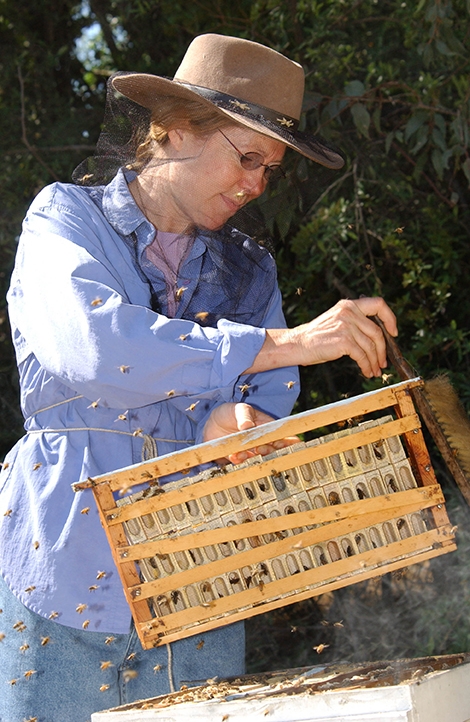
The video is "a guideline, that bees respond to selection but they need to be aware of some of the pitfalls that can hamper progress," said Lawrence, county director of WSU Extension for Island County. He's been working with bees since 1963 and landed his first commercial beekeeping job in 1969.
Sheppard says in the introductory remarks: "Honey bees are fascinating animals to work with and essential to pollination of our food supply. Currently faced with many challenges, one of our most important tools for long-term sustainability and improved honey bee health is a program of selection for stock that is hearty, productive, winters well, and has a reduced susceptibility to pests and pathogens."
Sheppard, Cobey and Lawrence know their bees. Between them, their bee experience encompasses some 150 years. Cobey, a bee breeder-geneticist who began working with bees in 1976, studied with Laidlaw, and later managed the Laidlaw facility. She is recognized as a global expert on instrumental insemination. Sheppard, who specializes in genetics and evolution of honey bees, and insect introductions and mechanisms of genetic differentiation, began working with bees while a graduate student at the University of Georgia.
In the video, Sheppard points out that "beekeepers recognize the need for more rigorous programs to select, improve and maintain their breeding stocks. The varroa mite and the movement of Africanized honey bees adds to this urgency. The principles discussed here serve as a guide to develop and establish a successful and practical breeding program with a focus on the traits you choose to enhance is your breeding population."
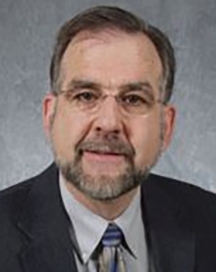
- Maintain a diverse population to provide the basis for selection
- A proficiency in queen and drone rearing
- Establish a selection index of desired traits
- Careful record-keeping
- Control of pests and diseases, and
- A method of controlled mating.
"The honey bee colony is a superorganism and this complicates the selection process," says Cobey, who breeds Carniolan bees. "Keeping your breeding program simple is key. Genetic diversity within the colony as well as within the population increases honey bee fitness. Several mechanisms contribute to this diversity:
- The high mating frequency of the queen.
- Semen storage--after mating only about 10 percent of the semen collected migrates to the spermatheca, although this represents each drone she has mated with."
- The high rate of recombination. a queen can mate with up to 60 drones, though typically mates with 15 to 20 drones. This mating behavior seems risky and inefficient, though is very successful in creating a genetically diverse superorganism, the colony."
"The many subfamilies of worker bees represented by the different drones mated, subfamilies specialize in different traits," Cobey says, "which together contribute to colony fitness."
She relates that "beekeepers and bee researchers have been selecting the honey bee for many years--some of the earliest attempts included attempting to mate bees in a confined enclosure or by hand .discoveries in the queens anatomy and physiology led to the first break through in controlled mating of honey bees with instrumental insemination.we owe a lot to some of the early pioneers in bee breeding like Laidlaw, (Lloyd) Watson, (Otto) Mackensen, (William) Roberts and many others."
Page-Laidlaw Closed Population Breeding Program
Noting that the Page-Laidlaw Closed Population Breeding Program "is one of the most successful practical breeding systems used, Cobey explains "the system basically is how most beekeepers approach selection--choose the best and propagate from these. The key component is an annual selection program supported with controlled mating and record keeping. Beekeepers rely on natural selection pressure to increase desirable traits in the population. The goal of the closed population breeding program is to increase the selection pressure and the frequency of desirable traits in the breeding population. Given the behavioral complexity of honey bees, this can be a challenging process. To be successful and give the program, longevity, it must be simple and repeatable."
The video drew nearly 1,000 views the first week. The first comment: "Great video! ....where can i buy that bee hat that Susan is wearing? Thanks so much!"
Cobey does have some nice hats!
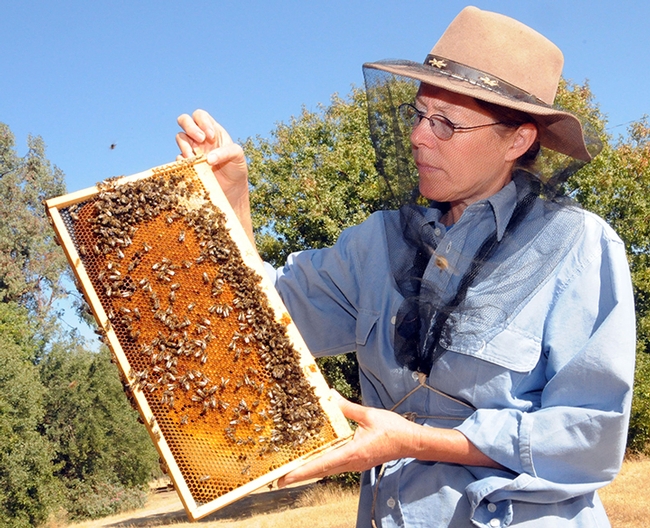
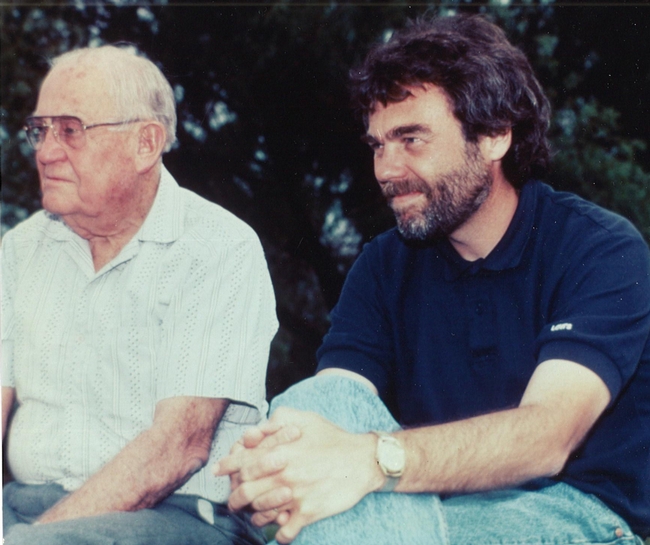
- Author: Kathy Keatley Garvey
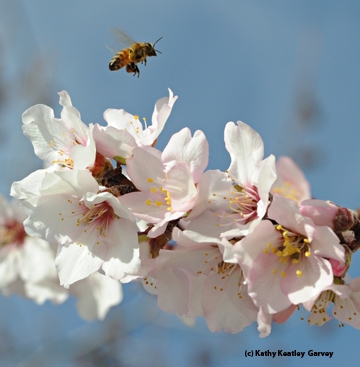
The beekeepers will be there!
The California State Beekeepers' Association (CSBA) will meet for its 128th annual convention, Tuesday through Thursday, Nov. 14-16, at Harrah's Lake Tahoe. The theme: "Inputs, Outputs and Expectations." Secretary of Agriculture Karen Ross will deliver the keynote address at 10:30 a.m., Tuesday.
President Steve Godin of Visalia will helm the three-day conference, aided by first vice president Mike Tolmachoff, Madera; second vice president Brent Ashurst, Westmorland; and treasurer Carlen Jupe of Salida. Their scientific advisor is Extension apiculturist Elina Lastro Niño, based in the UC Davis Department of Entomology and Nematology.
Niño will speak on "Research Stories from the Niño Lab" at noon on Wednesday, Nov. 15. Staff research associate (and husband) Bernardo Niño of the Harry H. Laidlaw Jr. Honey Bee Research Facility will address the group at 10:30 a.m., Thursday on "Practical Solutions for the Beginner Beekeepers."
Extension apiculturist emeritus Eric Mussen of UC Davis will lead a "Bridging the Gap" panel at 11 a.m., Thursday. Bee breeder-geneticist Sue Cobey of Washington State University, former manager of the Laidlaw facility, will speak at 1:30 p.m., Thursday on "Collecting Honey Bee Germplasm in Europe and the Impact on Genetic Diversity in the United States." Basically, it's about building a better bee.
Among the many speakers are
- Randy Oliver of Scientific Beekeeping, Grass Valley, "Oxalic/Glycerin Application and Breeding for Mite Resistance," at 3:30 p.m., Tuesday
- Bob Curtis of the Almond Board of California will provide an update at 8:30 a.m., Wednesday
- Dennis vanEnglesdorp of the University of Maryland faculty and project director for the Bee Informed Partnership, whose topic is "Managing Reistance in Varroa Mite Populations" at 10:30 a.m., Wednesday
- Marla Spivak, MacArthur Fellow and McKnight Distinguished Professor in Entomology at the University of Minnesota, who will discuss "Bee Health and Social Immunity" at 11 a.m. Wednesday
All in all, it promises to be an educational and informative conference, centered on our littlest agricultural workers: the honey bees.
CSBA is headquartered at 1521 I St., Sacramento. The office can be reached at (916) 441-0302 or contact@californiastatebeekeepers.com.
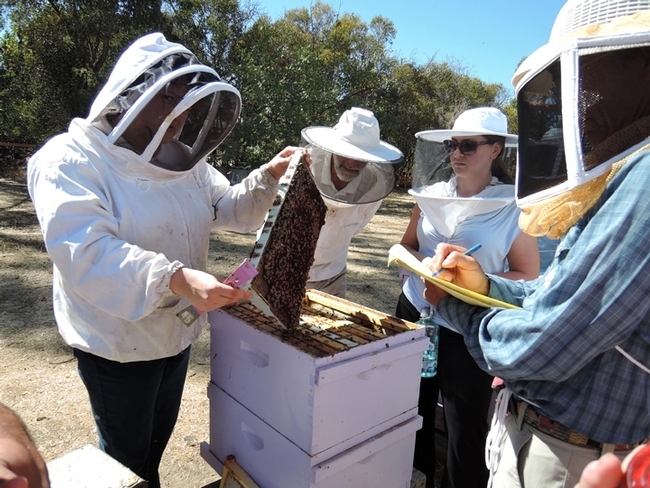
- Author: Kathy Keatley Garvey
It's August, 2007 and bee breeder-geneticist Susan Cobey, manager of the Harry H. Laidlaw Jr. Honey Bee Research Facility, University of California, Davis, is opening a hive in the apiary.
"Girls, where's your mother?” she asks again, pulling out another frame.
She quickly locates the queen bee, "the mother of them all." And "all" is not right in the bee world.
Susan "Sue" Cobey wants to "build a better bee."
Cobey, now a bee breeder-geneticist at Washington State University, seeks to maximize the good traits and minimize the bad traits. By controlling the genetics of honey bees (Apis mellifera), she says, researchers can breed stronger, more survivable bees--bees able to withstand such pests as varroa mites and such maladies as colony collapse disorder. “Controlled mating is the basic foundation of all stock improvement programs.”
Cobey who joined Washington State University's Department of Entomology in 2010, works with department chair and bee scientist Walter "Steve" Sheppard, who researches population genetics and evolution of honey bees, insect introductions and mechanisms of genetic differentiation; and bee scientist Brandon Hopkins, an expert on cryopreservation of bee semen.
"Building a better bee” involves collecting bee semen (germplasm) in European countries, including Italy, Slovenia, Germany, and the Republic of Kazakhstan. Those countries, she points out, rear bees with favorable genetic traits, such as resistance to varroa mites, the No. 1 enemy of beekeepers in the United States.
The dwindling gene pool diversity in the United States is troublesome, Cobey says. Although European colonists brought honey bees to the Jamestown colony in 1622, live honey bee imports have been banned in the United States since 1922.
So Cobey has been traveling to Europe since 2006--every year but 2016--to collect bee semen. “It took me 22 years to get that first permit," says Cobey. "It was opening the Canadian border to Europe that turned it--politics, not biology-based. We started asking (to collect bee semen in Europe) in the early 1980s with Harry Laidlaw's backing."
"My first trip to Europe was in 2006 from Ohio State University for carnica (Apis mellifera carnica, a darker subspecies) bee stock," recalled Cobey, who studied and trained with Harry Laidlaw, the father of honey bee genetics. Cobey joined the UC Davis Department of Entomology in 2007 and a year later, she began collecting bee semen in Europe with Steve Sheppard. The WSU bee breeding program involves crossbreeding honey bees to bolster their genetic traits. WSU is the only lab in the country with permits to import bee semen, and the only laboratory with the ability to freeze it. The WSU team uses liquid nitrogen to preserve the bee semen.
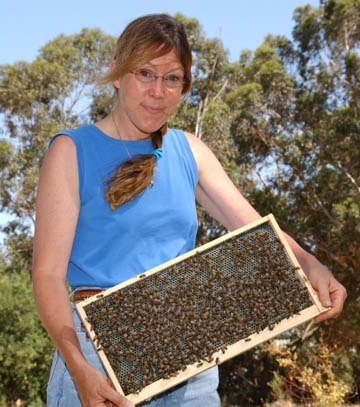
The European trip was memorable and productive. "Slovenia is a beautiful country with a long tradition of beekeeping," Cobey said.
"In Semič, Slovenia, we collected bee semen, met with the local beekeepers and gave presentations about our program,” Cobey said. “Afterwards we celebrated with a feast of roasted pig, hosted by Stane Plut."
"What a trip that was (to Italy and Slovenia)!" said Park-Burris. "Slovenia only allows the beekeepers to keep Carniolan bees. Sue was in heaven and it was fun to see how excited she got about her bees. Likewise I was really happy to see the Italy stock in Bologna again. The beekeepers there were so excited that we wanted more of their stock. Their hospitality was overwhelming."
Park-Burris marveled that the Slovenians keep almost all of their hives in "houses" and "then they paint pictures on them that tell a story. It was very interesting. One Slovenian told me that they treat their bees like pets and that was so true!"
Cobey is an international authority on the instrumental insemination of queen bees. She's taught the specialized technique for more than three decades, instructing students how to extract semen from a drone, and inseminate an anesthetized virgin queen. Magnified images on a computer screen help illustrate the procedure.
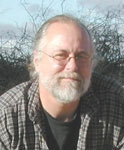
Cobey began training students in instrumental insemination in 1984. "This has taken me all over the world--currently I have invitations/inquiries to six countries," said Cobey, who has set up a lab at her home on Whidbey Island to teach workshops. Husband Timothy Lawrence, also a veteran beekeeper, is an associate professor and the county director (Island County) of Washington State University Extension.
"I receive three to five requests for classes per day here; I'm sorting these to the most needed/most serious," Cobey said. "The interest is much more serious. But note--still many struggle with this, as there are many aspects, including the specialized beekeeping that goes with it."
Cobey recently taught UC Davis staff research associates and beekeepers Bernardo Niño and Charley Nye of the Elina Lastro Niño lab in a three-day class in her lab. "I'm just doing small classes so I can give more individual attention, and concentrate on the details. So I have just three or four people per class. I hope UC Davis starts some classes as the interest is overwhelming." A UC Davis goal is to offer classes in 2018 or 2019, according to Niño.
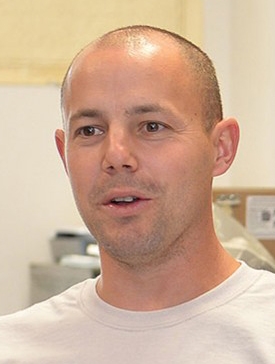
Some of Cobey's students go on to teach others the technique. UC Davis graduate Elizabeth Frost learned from Susan Cobey while working as her staff research associate at the Laidlaw facility. "She is now teaching instrumental insemination in Australia," Cobey said.
Cobey traces her interest in bees back to the 1970s. After enrolling in a student exchange program in entomology in 1975 at Oregon State University, Corvallis, she received her bachelor's degree in entomology in 1976 from the University of Delaware, Newark. From 1978 to 1980, she worked at UC Davis, where she was influenced by Harry Laidlaw (1907-2003).
Laidlaw perfected artificial bee insemination technology. “He discovered the valve fold in the queen bee which hinders injection of semen into the lateral oviducts,” Cobey said. “He developed instrumentation to bypass the valve fold enabling the success of bee insemination.”
Utilizing the training, Cobey established the Vaca Valley Apiaries in Vacaville in 1982, developing the highly regarded New World Carniolan Breeding Program. The Carniolans, originally from the Austrian Alps and the Balkans, are darker than the popular Italian honey bees, the most common subspecies in the United States. The Carniolans are known for their gentle behavior, and may be more suited to cooler weather.
In 1990 Cobey pulled up roots—and hives—and settled in Ohio, serving as staff apiarist at the Rothenbuhler Honey Bee Research Laboratory at Ohio State University until accepting the staff research associate position and manager of the UC Davis facility in 2007.
Now she's focused on the WSU bee breeding program, which produces breeder queen bees, which are then provided to commercial queen bee producers, who in turn can produce thousands of queen bees for the nation's beekeepers. The goal is to preserve and improve the stock of honeybees and to prevent subspecies from extinction.
Hopkins says that genetic diversity offers improved bee fitness and productivity. A genetically diverse colony handles diseases better. The biggest need in the U.S. honey bee population is anything that would increase resistance to parasitic Varroa mites, Hopkins says. (See WSU post.)
Cobey is featured in a National Public Radio piece, "No Offense, American Bees, But Your Sperm Isn't Cutting It."
"Honey bees aren't native to America," Cobey told reporter Ryan Bell. "We brought them here. But the U.S. closed its borders to live honey bee imports in 1922, and our honey bee population has been interbreeding ever since."
"Girls, where's your mother?"
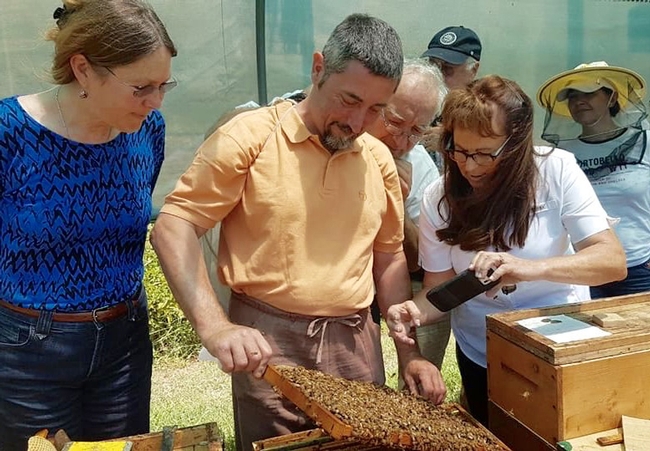
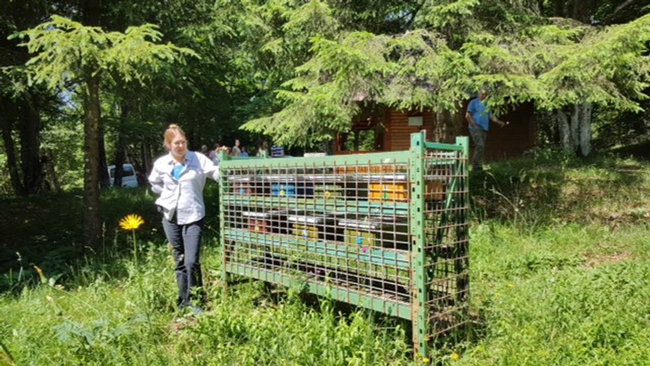
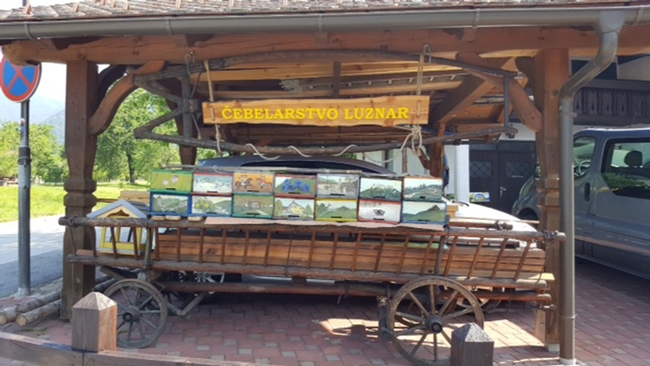
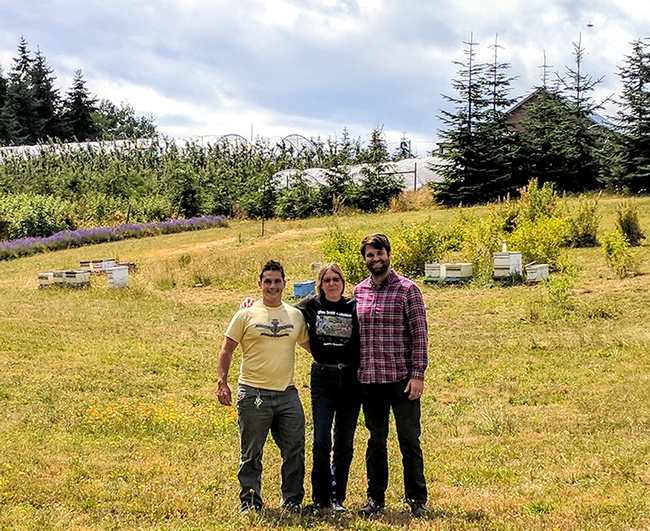
- Author: Kathy Keatley Garvey
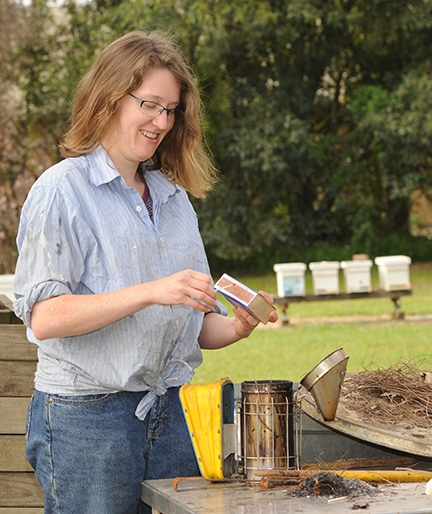
She's the newly hired honey bee development officer, an Extension-like position, in the state of New South Wales.
Frost left the States last Sunday, Jan. 10. The government position involves working with the commercial beekeeping industry in New South Wales in "course development and training, policy making, and other projects, including the importation of honey bee semen to Australia, and oxytetracycline prescriptions for European Foulbrood treatment, etc." she related.
We first met Liz in 2008 when she joined the Harry H. Laidlaw Jr. Honey Bee Facility as the staff research associate for bee breeder-geneticist Susan Cobey, then manager of the facility. Among her many duties, Frost maintained the apiaries and lab facilities, and aided in experiments and instruction in queen rearing and instrumental insemination.
We watched her lead tours with Cobey, now a geneticist-bee breeder at Washington State University; harvest honey; learn to drive the stick-shift bee truck; plant a pollinator garden in front of the Laidlaw facility; engage in a (private) bee bearding activity directed by Cobey; and even install pigeon-control devices on the eaves of the facility.
Frost also hosted the annual "Pi Day" every March 14 for faculty, staff and students at the Laidlaw facility. We all brought pies to celebrate the mathematical constant π (pi).
The Laidlaw facility buzzed with the enthusiasm, commitment and dedication of the Cobey/Frost team.
Frost, who holds a bachelor of arts degree in English and Italian from UC Davis with a minor in entomology, left the Laidlaw facility to join the Bee Informed Partnership, based in College Park, Md. (read her posts), and then headed off to Australia to become a honey bee development officer with the New South Wales government. From California to Australia...and now it's back to Australia...
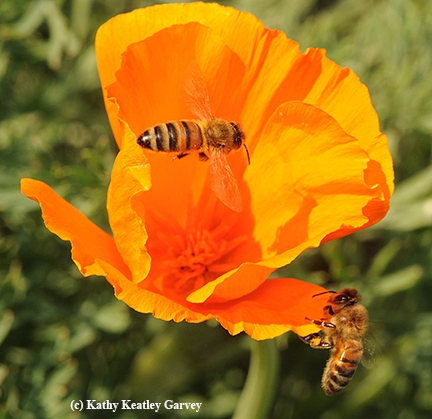
As a honey bee development officer, she created educational tools for beekeepers in the form of an online Honey Bee Pest and Disease Course, a Queen Bee Breeding book in hard copy and online publication (iBook and EPUB), a bimonthly column (The Frost Report) in the New South Wales Apiarist Association magazine (Honey Bee News), face-to-face courses in queen breeding, and online fact sheets.
About the pest/disease course: "If a beekeeper with one or thousands of colonies wants to learn more about honey bee pests and diseases this course is a valuable, interactive tool with tutorials including videos to supplement the text, and short quizzes," she explained. "In Australia this is a nationally accredited course which awards participants units of competency upon successful completion of assessment tasks."
Her fact sheet on Hygienic Behavior Testing includes step- by-step instructions with illustrations. "Hygienic behavior is a honey bee trait which confers resistance to chalkbrood and American foulbrood (AFB), two serious brood diseases in Australia. AFB is especially serious in Australia considering it is illegal to treat AFB infected hives with oxytetracyline (OTC) as it only masks the symptoms and can contaminate honey. This fact sheet and others produced by New South Wales Dept. of Primary Industry Apiary Technical Officers are located on this site.
She also taught a course on queen bee breeding in Australia with co-worker Doug Somerville. The late Gretchen Wheen, a pioneer in instrumental insemination in Australia, played key roles in establishing two bee breeding programs in Western Australia and the Eastern States (Queensland, New South Wales, Victoria) and the Eastern Creek Quarantine Station which enabled safe, legal importation of new honey bee stock. (The course is listed on this site.)
"These products are educational tools for beekeepers worldwide, but are specifically geared toward the Australian beekeeping industry in regard to the subjects of relevant endemic and exotic pests and diseases and seasonal management and floral resources," Frost related. (She also appeared in this news media-produced video: "Frost Spreads the Beekeeping Gospel.")
When her VISA expired, Frost returned to the states and engaged in a number of projects, including a recent presentation to the California State Beekeepers' Association conference. She toyed with other apiculture opportunities in the States, but when the Australian opportunity surfaced, she made a beeline to return.
Liz Frost is excited to be back.
"Beekeeping in the Australian context is fascinating, not only because Varroa is absent in this country," she said. "The wealth of potential floral resources is astounding, giving beekeepers the opportunity to chase honey 12 months of the year. Around 70 to 80 percent of honey produced commercially is derived from eucalyptus and native forests. These stats shouldn't deceive the reader into thinking honey is easily had, however. The most successful honey producers in Australia know their country intimately. Part arborist, part meteorologist, and all beekeeper, they monitor buds on trees years in advance of a flowering event.
"Also to be considered is the fact that, while some native melliferous flora such as Yellow Box and Ironbark are profuse nectar producers in the right conditions, they can be seriously deficient as a pollen resource. This situation makes beekeeper management decisions before and after working such a honey crop vital to prevent colonies from working themselves to death in the absence of incoming and nutritious pollen."

